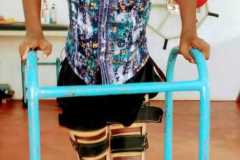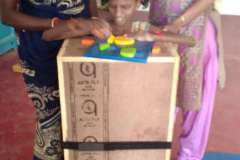Core Programmes
Core Programmes
Children Orthopaedic and Rehabilitation Resource Centre
The Children Orthopaedic and Rehabilitation Centre at Mylaudy was originally established by Dr. Zippel from Germany under the ownership of Patengeminschaft in 2003. Since 2016, Pro-Vision took over the management and responds to the existing and emerging needs of the children and adults.
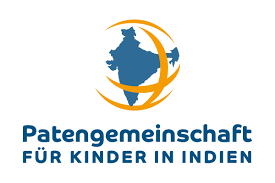
APPROACH AND STRATEGIES
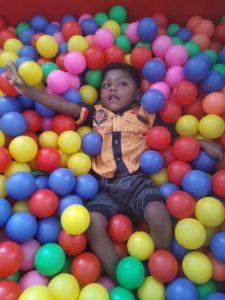
Without compromising on the original vision of the institution,
Pro-Vision expanded its response to accommodate the emerging
needs. Priority attention is paid to children with special
needs, though the adults are treated for specific conditions.
Though the primary focus is on cerebral palsy, the following
conditions are also dealt with, as they are seen to be more
prevalent in the local area.
The approach of CORC is comprehensive, pro-active, and
individualized to enable them to achieve maximum physical,
intellectual and emotional development. CORC concurrently
educates patients, parents and the community about children with
special needs particularly children with Cerebral Palsy.
| Cerebral Palsy | Global developmental delays |
| Muscular Dystrophy | Autism Spectrum Disorder |
| Attention Deficit Hyperactivity Disorder | Hyperactive behaviour |
| Speech and Language problems | Sensory impaired |
| Emotional and Behavioural | Multiple disabilities |
| Problems |
In line with its vision and approach, each child is given need-based interventions with a planned impact in the lives of children with cerebral palsy. Accordingly, the therapeutic interventions are designed for each child, which include but not limited to:
- Assessment & Diagnosis
- Physiotherapy
- Speech Therapy
- Special Education
- Hydrotherapy
- Group Therapy
- Environmental Sensitivity
- Early Intervention
- Occupational Therapy
- Sensory Integration
- Skills Development
- Play and Recreation
- Outdoor Activities
- Parent Education
Comprehensive development of children calls for stimulations where the children feel, experience and learn from every activity and inputs. Keeping in mind, individualized interventions are planned to meet the needs of each child.
Assessment and Diagnosis
The procedure of assessment and diagnosis of children with special needs and disclosure to their parents is a complex, emotional and sensitive process. Often parents express low satisfaction in a healthcare professional’s approach. However, this is not inevitable. A parent’s experience with a healthcare professional at the time of diagnosis can have a long-lasting impact on their ability to cope with the child’s condition and support the child’s development. Our staff are trained and motivated to understand the position of the parents and prepare them to accept their children and plan treatment and therapies for their children.

Early Intervention: Early identification and early intervention provide children the opportunities to maximise their developmental potential and quality of life. Evidences consistently demonstrate that children identified with a developmental disability at an early age have improved long-term outcomes, across both functioning and life satisfaction. Hence more attention is paid for early identification and intervention, though it is not often easy to convince the parents and enlist their support.
Physiotherapy: The uniqueness of the service deliveries is Neuro Developmental Therapy (NDT) based on mile-stone developments is the central link of intervention. Vojta stressing on reflex actions, Bobath emphasizing on active movements and Proprioceptive Muscular Facilitation (PNF stretching) focusing on muscular flexibility are practiced in a vivid combination as to bring about optimum level of functioning of the children with CP.
Occupational Therapy: Occupational therapy intervention aims at developing, recovering or maintaining meaningful activities or occupations to children individually or in groups. The common interventions help children with special needs to participate independent activity or movements. The occupational therapist works systematically with the children through a sequence of actions called the occupational therapy process which include assessment, intervention and evaluation of outcomes. Along with physiotherapy occupational therapy proves to be more effective for children with special needs.
Speech Therapy: This unit is mainly for the children who are not able to speak, properly pronounce, without proper pitch of the sound and clarity of words. Focus is given on SODA and support the children in engaging social communications with reception and expression.
Sensory Integration: With facilities for children enabled illuminations, music, audio-visual displays the sensory integration room could be converted into stimulation rich dark room. It facilitated trunk movements and eye-hand co-ordination. Through animation films in groups, observation and learning skills are promoted.
Special Education
Special education or special-needs educationis the practice of educating children with special needs such as children with cerebral palsy, Autism Spectrum Disorder, ADHD, communication disorders, emotional and behavioral disorders and enables them to acquire the desired skills Individual Education Plan (IEP) is developed for each child individually, practiced and monitored. These interventions are designed to help individuals with special needs achieve a higher level of personal self-sufficiency.
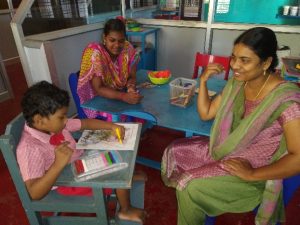
Hydrotherapy: A modern swimming pool is utilized for hydrotherapy every Wednesday and Saturday. Well accepted by parents and enjoyed by children hydrotherapy proves to be very effective in children with CP, particularly children with contracture or spasticity. It is also meaningful to children with autism spectrum disorder and hyperactive children.
Play and Recreation: The play therapy room was upgraded with stations for specific skills such as alpha-numerical, cognitive, motor skills, eye-hand co-ordination. The children feel, experience and learn colours, shapes, sizes, animals, birds and fruits. There is a special place for painting and drawing and facilities to develop activities of daily living.
Group Therapy

Four to six children with more or less similar developmental stages are assembled together for about half an hour and the required inputs are given in small groups. The group therapy inputs include but not limited to cognitive development, behavioural modifications, interpersonal relationships, communication skills. Group therapy is explicitly utilised as a mechanism of change process that takes place in a group.
Outdoor physical activities: The outdoor facilities for the children such as rope climbing steps, swings, toy cars, crawler board, zee saw etc.. facilitate active partaking with interest and involvement that has a therapeutic impact on their growth process.
Environmental sensitivity: CORC located in an eye pleasing rural ambience, appropriate for children with CP. With two aquariums, one birds cage and small birds and animals moving around, it provides a child friendly environment, wherein the children develop environmental sensitivity and learn with and from the nature.
Parent Education: In addition to the centre based activities, efforts are taken to meet the children in their home environment and support them in their development process. One of the main aims is to strengthen the family support system by enabling the parents to understand the conditions of the children and take necessary steps towards their rehabilitation and development. The family plays a very important role in the outcome in children with Cerebral Palsy. It is important that the entire family understands the nature and consequences of CP and knows how to handle them. Hence home visits were undertaken to educate the families and support them to extend proper care to the children. The CBR worker visits the families and the families were strengthened to provide proper care to the children. Those who did not come regularly were motivated to access therapies again.





















